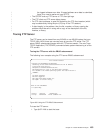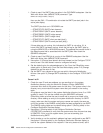
the logged software error data. If logged software error data is submitted,
there is no need to perform a trace of FTP.
v The QTCPIP and any FTP server or FTP client job logs.
v The FTP client and FTP server debug traces.
v For FTP client problems, a spool file containing the FTP client session (which
may be obtained by hitting the print (F6) key in the FTP session).
v If data integrity is the problem, then the file, member, or library causing the
problem should be sent in along with a copy of the description of the file,
member, or library.
Tracing FTP Server
The FTP server can be traced from any AS/400 or non-AS/400 system that runs
TCP/IP. With V4R4, there are now two ways to trace the FTP server. The FTP
server DBUG subcommand traces
within
an FTP server session. The new Trace
TCP/IP Application (TRCTCPAPP) command allows
system wide
tracing of
all
the
FTP servers.
Tracing the FTP server with the DBUG subcommand
The following is an example using the FTP server DBUG subcommand:
To trace the FTP server:
1. Type QUOTE DBUG to start the trace.
File Transfer Protocol
Previous FTP subcommands and messages:
Connecting to host name xxxxxnnn.xxxxxxxx.xxx.xxx at address
n.nnn.nn.nnn using port 21.
220-QTCP at xxxxxnnn.nnnnnnnn.nnn.nnn.
220 Connection will close if idle more than 5 minutes.
215 OS/400 is the remote operating system. The TCP/IP version is
"V4R4M0".
>
331 Enter password.
230 TEST logged on.
250 Now using naming format "0".
257 "QGPL" is current library.
Enter an FTP subcommand.
===> quote dbug
F3=Exit F6=Print F9=Retrieve
F17=Top F18=Bottom F21=CL command line
Figure 256. Using the FTP DBUG Subcommand
Chapter 21. TCP/IP Problem Analysis 453
|
|
|
|
|
|
|
|
|
|
|
|
|
|
|
|
|
|


















